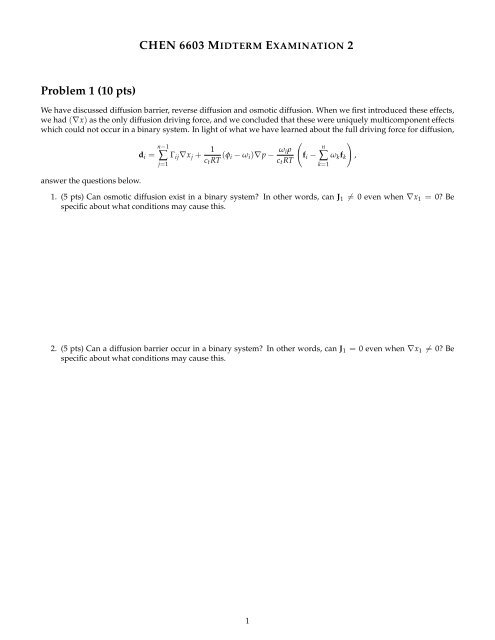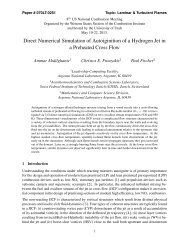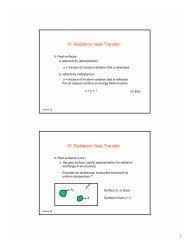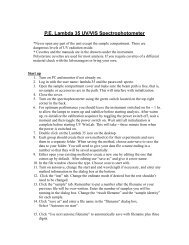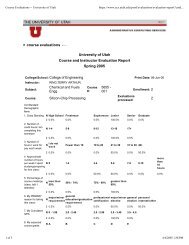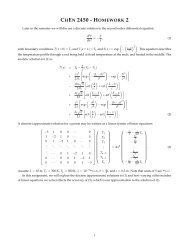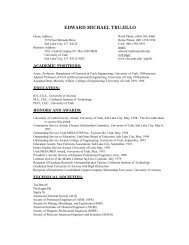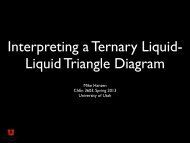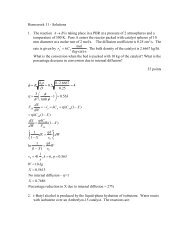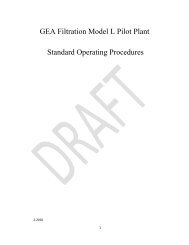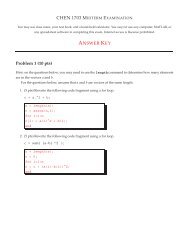CHEN 6603 MIDTERM EXAMINATION 2 Problem 1 (10 pts)
CHEN 6603 MIDTERM EXAMINATION 2 Problem 1 (10 pts)
CHEN 6603 MIDTERM EXAMINATION 2 Problem 1 (10 pts)
Create successful ePaper yourself
Turn your PDF publications into a flip-book with our unique Google optimized e-Paper software.
<strong>CHEN</strong> <strong>6603</strong> <strong>MIDTERM</strong> <strong>EXAMINATION</strong> 2<br />
<strong>Problem</strong> 1 (<strong>10</strong> <strong>pts</strong>)<br />
We have discussed diffusion barrier, reverse diffusion and osmotic diffusion. When we first introduced these effects,<br />
we had (∇x) as the only diffusion driving force, and we concluded that these were uniquely multicomponent effects<br />
which could not occur in a binary system. In light of what we have learned about the full driving force for diffusion,<br />
answer the questions below.<br />
d i =<br />
(<br />
n−1<br />
∑ Γ ij ∇x j + 1<br />
c<br />
j=1<br />
t RT (φ i − ω i )∇p − ω iρ<br />
c t RT<br />
f i −<br />
n<br />
∑<br />
k=1<br />
ω k f k<br />
)<br />
1. (5 <strong>pts</strong>) Can osmotic diffusion exist in a binary system In other words, can J 1 ̸= 0 even when ∇x 1 = 0 Be<br />
specific about what conditions may cause this.<br />
,<br />
2. (5 <strong>pts</strong>) Can a diffusion barrier occur in a binary system In other words, can J 1 = 0 even when ∇x 1 ̸= 0 Be<br />
specific about what conditions may cause this.<br />
1
<strong>Problem</strong> 2 (14 <strong>pts</strong>)<br />
Recall the two-bulb problem that we discussed in class and that you solved in your homework (isothermal, isobaric,<br />
nonreacting ideal gases).<br />
1. (4 <strong>pts</strong>) Show that the species mole balance on a bulb can be written as c t V dx i<br />
dt<br />
the bulb and A is the area of the tube.<br />
= −J i A, where V is the volume of<br />
2. (4 <strong>pts</strong>) Show that the species profiles in the tube can be written as x i = xL i −x0 i<br />
L<br />
z + xi 0, where x0 i<br />
is the composition<br />
in the bulb at z = 0, and xi L is the composition in the bulb at z = L. Indicate assumptions you make.<br />
2
3. (6 <strong>pts</strong>) Below is a figure showing the composition in each bulb as a function of time. Using this information,<br />
indicate evidence of multicomponent effects. Be as specific as you can in your arguments, including identification<br />
of reverse diffusion, osmotic diffusion, and diffusion barrier if they exist. This will likely require you to<br />
justify how you will obtain quantities such as J i and ∂x i<br />
∂z<br />
from the plots below.<br />
(a) Bulb 1 at z = 0. (b) Bulb 2 at z = L.<br />
Figure 1: Composition histories, x i (t).<br />
3
<strong>Problem</strong> 3 (15 <strong>pts</strong>)<br />
1. (3 <strong>pts</strong>) Does linearized theory require the assumption that [D] is constant Why or why not Be specific.<br />
2. (3 <strong>pts</strong>) Does effective diffusivity require the assumption that [D] is constant Why or why not<br />
3. (4 <strong>pts</strong>) Assuming that you solved a problem using an effective diffusivity approach to obtain x i (z, t), how might<br />
you determine if you need to revise your solution to include multicomponent effects<br />
4. (5 <strong>pts</strong>) Recall for the two-bulb problem we obtained the solution for the species profiles in the tube:<br />
x i = xL i<br />
− x 0 i<br />
L<br />
z + x 0 i , (1)<br />
where x 0 i<br />
is the composition in the bulb at z = 0, and x L i<br />
is the composition in the bulb at z = L.<br />
If we wanted to use a mass-transfer coefficient approach to obtain (J) within the tube, define [k • ] , [k] (low-flux<br />
mass transfer coefficient) and [Ξ] (the correction factor matrix).<br />
4


